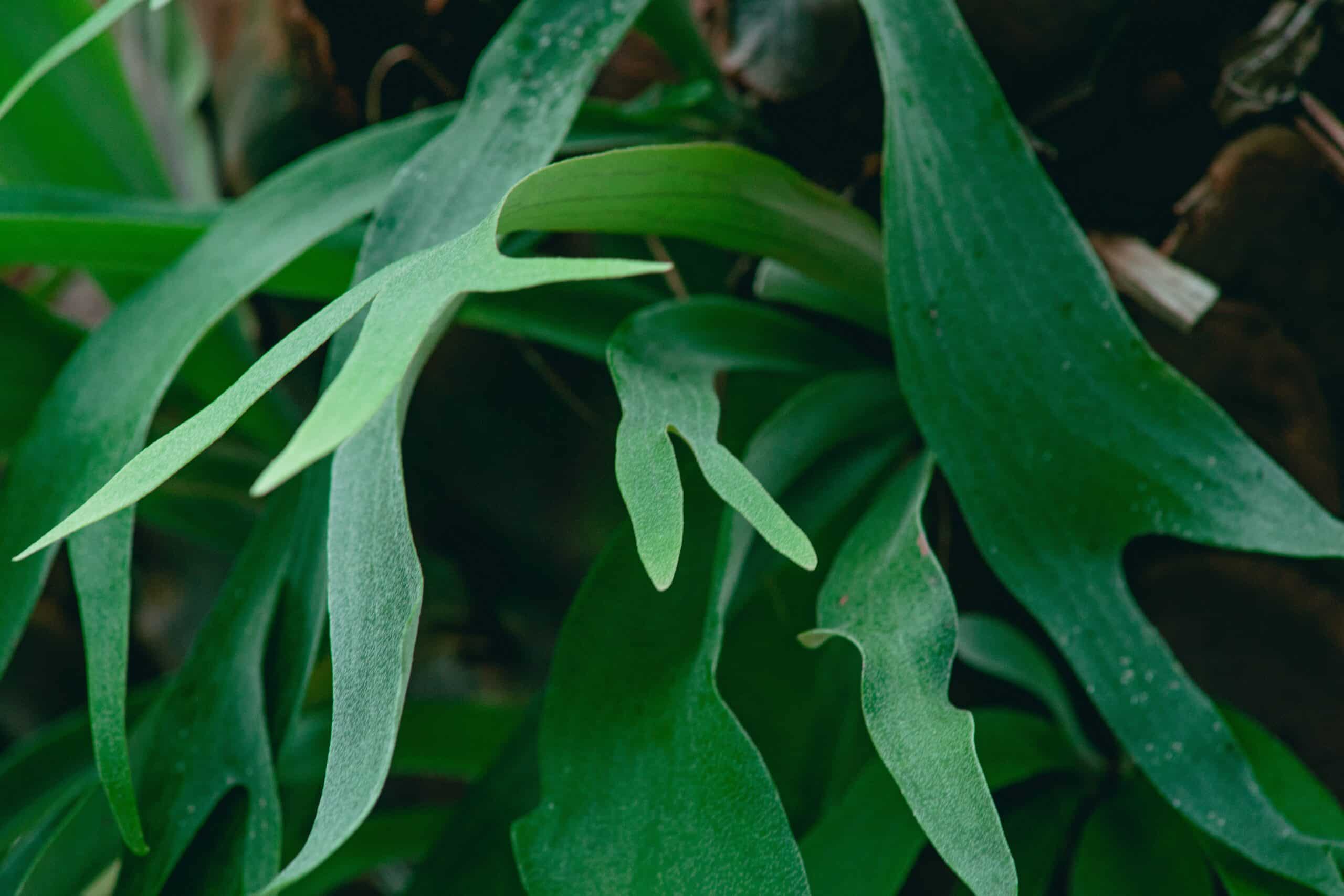As humans, we have a long-standing relationship with nature and plants. The Staghorn Fern is a beautiful example of how we can come together to coexist in harmony with our botanical friends. This plant offers a unique opportunity for us to nurture our environment and ourselves as we take care of it. With its impressive size, distinctive antler-like shape, and interesting texture, this tropical fern will add an exotic touch to any home or garden.
The Staghorn Fern is an epiphytic fern native to tropical areas of the world. It gets its name from its antler-like fronds that look like the horns of a stag or deer. These unusual fronds grow in two shapes: the larger shield fronds which form the base of the plant and the smaller antler-like fronds (or “rachis”) that grow upright from the shield frond. Growing up to five feet tall, these remarkable plants can make quite an impression when they are in full bloom!
Caring for your Staghorn Fern is relatively simple, but there are some important considerations you must keep in mind if you want it to thrive. In this article, we will explore all aspects of caring for your Staghorn Fern: from proper light exposure and water requirements to fertilizing and repotting tips. Read on for everything you need to know about cultivating these remarkable plants!
What Is A Staghorn Fern?
The thought of having a plant in your home that looks like it belongs in the wild can be intimidating. But don’t let that deter you from considering a staghorn fern! These fascinating plants are surprisingly easy to care for and make a great addition to any home—whether you have outdoor or indoor space.
So, what is a staghorn fern? Well, they’re tropical epiphytic plants native to warm climates like Australia and South Africa. They get their name from their antler-like fronds, which form an ideal habitat for beneficial insects and other wildlife. But unlike many other antler-like plants, staghorn ferns don’t require lots of soil or water to survive. All they need is good air circulation and enough humidity.
What makes them so unique is that they don’t need traditional potting soil, either. Instead, they prefer to grow on trees or other surfaces (like cork bark) where moisture can easily evaporate away from the roots. Staghorn ferns are also easy to propagate if you’d like more of them in your home – all it takes is some patience! All of this makes them an ideal choice for low-maintenance gardeners who want something beautiful without too much effort.
Now that we’ve established why staghorn ferns are such great houseplants, let’s move on to exploring where these stunning plants thrive best…
Where Do Staghorn Ferns Grow?
Staghorn Ferns are an exotic and unique plant that can add a bit of life to any home or outdoor space. Though they may look delicate, they are actually quite resilient plants when you know where to place them. If you’re looking for a new addition to your home, here’s what you need to know about where staghorn ferns grow best.
Staghorn ferns love warm, humid climates with plenty of indirect light. They do best in bright but filtered sunlight – like the kind found in a sheltered porch or beneath the canopy of trees. If you don’t have access to these kinds of environments, try placing your fern near a window that gets a good amount of bright morning sun, followed by some afternoon shade.
When it comes to soil, staghorn ferns prefer something that is well-draining and organic – think compost or leaf mold mixed with peat moss or sand. You’ll also want to make sure that whatever container you choose for your staghorn fern has adequate drainage holes so that the soil doesn’t become soggy and cause root rot.
By taking into consideration the type of climate and soil your staghorn fern needs, you’ll be able to create the perfect environment for it to thrive in. Now let’s take a look at how to choose the right container for your new plant friend!
Choosing A Container For Your Staghorn Fern
As if grasping onto the sun, staghorn ferns have a tenacious hold on life. Choosing the right container for your staghorn fern is essential to ensure it can live to its fullest potential. When selecting a container, look for something that offers plenty of air circulation and is big enough to accommodate the plant’s roots as they spread.
First, determine how much light your fern needs. If you plan to keep it outdoors, make sure the container has drainage holes so that water can escape. Consider materials such as plastic or metal with a durable finish, like galvanized steel or powder-coated metal. A wooden box with slats or an open-weave basket provide good air flow and make excellent holders for staghorn ferns too.
Second, determine what size pot you need by measuring the width of the fronds when spread out and adding about 10 inches for each side. You want something wide and shallow rather than deep because staghorn ferns have shallow root systems and do not need a lot of depth in their containers. And lastly, select a potting mix specifically designed for epiphytes—plants adapted to living on other plants—such as staghorn ferns since they don’t grow in soil like other plants do; they thrive in organic matter like mosses, bark chips, and charcoal instead.
With an appropriate potting mix and container chosen, your staghorn fern will be ready to thrive! Now let’s move onto preparing soil for your new addition – one that ensures healthy growth and lush foliage year over year.
Soil For Staghorn Ferns
It’s often thought that staghorn ferns are difficult to care for, but with the right soil, container and water requirements, they can be an easy-to-maintain indoor plant. So what’s the best soil for staghorn ferns? Let’s investigate.
The ideal soil for your staghorn fern should be a mixture of peat moss and potting mix. This combination will create a light and airy potting mix with good drainage. The addition of perlite or sand can also help improve aeration and drainage which is essential for this plant species. You don’t want your soil to be too soggy or else it could lead to root rot.
When planting your staghorn fern in a new container, make sure you add enough potting mix to cover the roots without burying them too deep. Gently compress the soil around the roots and then water thoroughly to get rid of any air pockets. Maintaining well-drained soils will help ensure that your staghorn fern stays healthy and happy! With proper care, you’ll have a beautiful indoor plant that adds life and color to any room in your home. Now let’s look at how important water is when caring for these plants.
Water Requirements For Staghorn Ferns
Growing staghorn ferns is like running a marathon—it takes consistent effort and commitment for success. Proper water requirements are essential for the health of your staghorn fern, just like hydration is critical for any athlete during a race.
When it comes to watering, it’s important to recognize that every staghorn fern is different. It’s best to check the soil before watering to make sure that it’s dry. When the soil appears dry, you can give the plant a thorough soak. Make sure you don’t over-watering as this will cause root rot and potentially kill your plant.
For long-term care, try using rain or distilled water instead of tap water if possible. The mineral content in tap water can build up over time and lead to nutrient deficiencies in your plants. If you do use tap water, let it sit out overnight so that some of the minerals have time to dissipate before applying it to your staghorn fern.
By supplying adequate water to your staghorn fern on a regular basis, you can ensure its health and help it thrive for years to come. Now that we’ve covered proper watering requirements, let’s take a look at temperature and humidity needs for these remarkable plants.
Temperature And Humidity For Staghorn Ferns
It’s understandable to think that staghorn ferns would require an intensely warm and humid environment, but the truth is that these plants thrive in moderate temperatures. In fact, temperatures that are too hot or too cold can cause damage to the plant. So, let’s take a look at what temperature and humidity conditions are ideal for staghorn ferns.
When it comes to temperature, staghorn ferns prefer room temperature conditions between 65-75°F (18-24°C). Temperatures outside this range will cause stress in the plant and can lead to yellowing of leaves or even death. When it comes to humidity, it is best to keep levels at an average of 40%. Anything below 35% could result in browning of leaves while anything above 50% could lead to root rot.
Humidity levels can be increased by misting the leaves with water or placing a tray of pebbles and water near the plant. To reduce humidity levels, you could invest in a dehumidifier or open windows when temperatures allow during summer months. With careful consideration of temperature and humidity requirements for staghorn ferns, you can ensure your plants have a healthy environment for them to grow and flourish.
Light Requirements For Staghorn Ferns
Light is an absolutely essential part of staghorn fern care, and a seemingly minor mistake in this regard can have serious consequences for your plant’s health. Fortunately, staghorn ferns are quite adaptable when it comes to light, though they do have some specific needs that you’ll want to consider as you plan out the care of your plant.
Staghorn ferns thrive best in bright indirect light, meaning that they should be kept away from direct sunlight. An east-facing window may be ideal for these plants as it will provide them with ample morning light but not too much intensity later on in the day. Many people also opt for artificial sources like fluorescent or LED lights, which can help provide the necessary illumination without any of the risks associated with natural sunlight. Whatever option you choose, make sure that the light source is no more than a few feet away from your plant at all times.
It’s important to note that staghorn ferns generally don’t need a lot of light in order to thrive. If you find that your plant is getting too much direct sun, simply move it closer to a window or other source of indirect light. Additionally, if you feel like your plant could use more brightness than what it’s currently getting, then adding a supplemental LED or fluorescent lamp may be beneficial. With proper lighting and careful tending to other factors such as temperature and humidity levels, you’ll soon have a thriving staghorn fern!
Fertilizing Staghorn Ferns
Fertilizing your staghorn fern is an important step in keeping it healthy. While staghorn ferns are generally low maintenance plants, they do require some fertilizer to help them stay strong and vibrant. In this article, we’ll look at how to best fertilize your staghorn fern to ensure its long-term health.
When it comes to fertilizing a staghorn fern, you’ll want to use a balanced liquid fertilizer that is specifically designed for indoor plants like this one. You should apply the fertilizer once a month during the growing season and every two months during the winter months when the plant isn’t actively growing. Be sure to dilute the fertilizer according to the directions on the package so you don’t over-fertilize your staghorn fern.
It’s also important to remember that over-fertilizing can be just as damaging as under-fertilizing, so it’s best not to go overboard with your applications. If you’re unsure of how much fertilizer to give your staghorn fern, talk to a knowledgeable nursery professional or gardening expert who can provide guidance on exactly how much you should be giving it.
Armed with this information, now you can confidently fertilize your staghorn fern and keep it looking its best! Onward we go into pruning techniques for these lovely plants!
Pruning Staghorn Ferns
“Necessity is the mother of invention”. Pruning staghorn ferns may not be essential, but it can be beneficial to the plant’s health and growth. The practice of pruning your staghorn fern will help maintain its shape, encourage new growth, and remove any dead or damaged fronds. It is important to understand the basics of pruning staghorn ferns so that you can take care of them properly.
The best time to prune a staghorn fern is in early spring before new growth has begun. During this time you should trim off any brown or dried fronds as well as any dead leaves that have accumulated during the winter months. You should also use sharp scissors or shears to cut away any fronds that are too long or overlapping each other. Pruning at this time will also help encourage new growth from the center of the plant.
Once you’ve trimmed away all of the dead material and excess foliage, you should inspect your staghorn fern for signs of disease or rot. If you find any areas that appear diseased, it’s best to remove them immediately as this could spread further throughout your plant if left untreated. Additionally, if your staghorn fern is growing in an area where it does not get enough light, it may need additional pruning to open up its canopy and allow light to reach its lower fronds.
By following these steps when pruning your staghorn fern, you can ensure it stays healthy and continues to thrive in your home garden. With proper care and attention, your staghorn fern can provide years of beauty and enjoyment. Now let’s move on to propagating staghorn ferns – an exciting endeavor!
Propagating Staghorn Ferns
Propagating staghorn ferns is like taking a leap of faith – you never know what to expect, but the potential rewards are great. If you’re ready to take the plunge and expand your collection, you’ll want to know the best way to propagate these unique plants. Here’s a guide to help you get started!
The simplest method for propagating staghorn ferns is division. You’ll need two pairs of clean hands and a sharp knife or pair of scissors. Start by carefully detaching offshoots from the mother plant. Be sure to cut close enough that each division has plenty of roots attached. Once separated, plant each division in its own pot with fresh soil and water generously.
It’s also possible to propagate staghorn ferns from spores, but this can be tricky and time-consuming. To do this, collect spores from mature plants in early spring or summer and place them on damp moss in an enclosed container. Keep the container in a warm place out of direct sunlight until the spores have germinated (this may take up to two months). When they’ve sprouted, carefully transfer them into individual pots filled with fresh soil and water regularly.
With patience and care, you can easily grow more staghorn ferns without spending a penny! Just remember that propagating doesn’t guarantee success – it takes time and effort to nurture new plants until they reach maturity. But if you’re willing to put in the work, there’s no reason why your new divisions won’t thrive! With this knowledge in hand, let’s look at some common problems associated with growing staghorn ferns…
Common Problems With Staghorn Ferns
Staghorn ferns are a unique and interesting species of plants, but they require specific care and attention in order to thrive. A staggering 80 percent of staghorn ferns don’t survive beyond their first year due to improper care, so understanding common problems is essential for keeping these plants healthy. Here’s what you need to know:
First, it’s important to pay attention to the amount of light your staghorn fern receives. Too little or too much light can cause the leaves to yellow and become brittle, leading to irreversible damage. You should also take into account temperature fluctuations; if the plant is exposed to temperatures below 55 degrees Fahrenheit for an extended period of time, it could be at risk for severe damage and even death. Finally, proper watering technique is key for staghorn ferns – water them deeply when the soil becomes dry, but make sure not to overwater as this can lead to root rot and fungal growth.
You can also look out for signs that your plant may be in distress, such as wilting leaves or brown tips on new growth. Paying close attention to these indicators will allow you to address problems before they become too severe. Additionally, if you see any signs of pests like mealybugs or aphids on your plant, act quickly by treating with an insecticidal soap spray or organic neem oil solution.
By being vigilant about common issues with staghorn ferns and using the right preventative measures, you can ensure that your plant continues thriving for years to come!
Signs Of Healthy Staghorn Ferns
Have you ever wondered what to look for when it comes to a healthy staghorn fern? It can be tricky to know if your fern is thriving or not, but there are some signs that you should look out for. In this article, we’ll explore the clues that your staghorn fern is happy and content.
One of the most obvious signs of a healthy staghorn fern is new growth. If you’re seeing fresh fronds sprouting up, then your plant is thriving in its environment. New fronds should be bright green and have a lush texture. Additionally, make sure to check for any new roots growing from the base of the plant.
Another thing to look out for is the overall color of the leaves and stems. Healthy plants have a vibrant green hue throughout their foliage and stems. If you notice any browning or yellowing on the fronds, then it could be an indication that something isn’t quite right with your plant’s care routine. Lastly, observe how often your fern needs watering; if it retains moisture well without needing frequent waterings then this could also be a sign that your staghorn fern is doing well.
By being mindful of these signs, you can ensure that your staghorn fern remains healthy and happy! Without further ado, let’s move on to some tips for success with staghorn ferns…
Tips For Success With Staghorn Ferns
Success with staghorn ferns starts with smart strategies. Sure, you can pick up tips from experienced gardeners, but there’s a lot more to it than that. To ensure success, you’ll need to pay attention to the signs of a healthy plant and make sure your staghorn fern gets the right care.
When it comes to growing these beautiful plants, preparation is key. Start by providing plenty of bright indirect light and keeping the soil moist yet well-drained. You’ll also want to fertilize regularly and keep an eye out for pests and disease – more on that later! Finally, be sure not to overwater or overfertilize your fern as this can lead to root rot.
These are just a few of the tips for success with staghorn ferns that you should keep in mind. With proper care and good habits, you can enjoy having these unique plants adorning your home for years to come. So don’t forget: provide plenty of light, water wisely, and watch out for pests and diseases – all essential steps in keeping your staghorn fern looking its best. Next up: tackling pests and diseases of staghorn ferns!
Pests And Diseases Of Staghorn Ferns
Preparing for pests and diseases of staghorn ferns is almost like an extreme sport: it’s a wild ride! But with the right knowledge and care, you can be sure that these majestic plants will stay healthy. Here’s what you need to know about keeping them safe from any potential harm.
First off, prevention is key in ensuring that your staghorn ferns remain healthy. Here are some tips to help you keep pests and diseases away:
- Monitor your plants regularly for signs of disease or insect damage.
- Make sure that they have plenty of air circulation, as this can prevent many common problems.
- Water them appropriately and avoid overwatering or underwatering them.
- Use organic pest control methods such as neem oil or other natural insecticides if necessary.
In addition to preventive measures, there are also some steps you can take to treat diseases and pests if they arise. Here are some tips:
- Remove diseased foliage as soon as possible and dispose of it properly.
- Prune affected branches to encourage new growth and reduce the spread of disease.
- Carefully inspect your plants for signs of insects or larvae, such as holes in leaves or webbing around stems, and use an appropriate pesticide to eliminate them.
With proper monitoring and timely intervention, you can make sure that your staghorn ferns remain healthy and beautiful for years to come. Taking preventive measures now will help ensure that your plants stay vibrant and thriving—so don’t hesitate to get started!
Staghorn Fern Varieties
Staghorn ferns are among the most unique and beautiful plants, with more than 20 varieties available in various forms. Interestingly, staghorn ferns can live up to 30 years when well cared for. Whether you’re a beginner or expert gardener, there is a variety of staghorn ferns to choose from that will suit your needs.
When selecting a staghorn fern, you should consider its size, shape, texture and light requirements. Staghorn varieties come in different shapes and sizes ranging from small clumps of thin fronds to large multi-layered fans which can reach up to 3 feet across. Additionally, they vary in texture from coarsely wavy to finely textured fronds depending on the species. When it comes to light requirements, some varieties like bright indirect light while others prefer filtered sunlight or shade.
To help you make an informed decision about which staghorn fern variety would work best for you, here’s an overview of three popular types: • Platycerium bifurcatum – This is one of the easiest and most popular types to grow as it requires minimal care and thrives in partial shade or indirect light conditions. Its unique fan-shaped fronds are ideal for adding depth and texture to both indoor and outdoor gardens.
• Platycerium coronarium – This species is known for its large size and feathery foliage that can reach up to 3 feet across when mature. It prefers bright indirect light but can also tolerate lower light levels with less water during colder months.
• Platycerium ridleyi – This type has long thin leaves that form attractive clusters making it perfect for creating lush yet delicate displays in hanging baskets or containers with plenty of shade provided. It is also quite easy to care for as long as it has adequate humidity levels throughout the year.
No matter which type of staghorn fern you choose, each can add beauty and character to any home or garden setting if given the proper care and attention. With a little bit of research into their needs before planting them, these fascinating plants will become the focal point of your home or garden landscape in no time at all!
Frequently Asked Questions
How Often Should I Water My Staghorn Fern?
When it comes to caring for staghorn ferns, watering is one of the most important factors. But how often should you water your staghorn fern? It’s a good question, and the answer depends on several different factors.
First, consider where the plant is located. If you have a warm climate with plenty of sunlight, then you will need to water more frequently than you would if the plant is kept in a cooler area with less light exposure. Additionally, soil type plays an important role in determining how often to water your staghorn fern. Soils that are more porous or contain more organic matter will require less frequent watering than soils that are clay-based and drain slower.
Finally, it’s also important to pay attention to the moisture levels of the soil around your staghorn fern. Feel the soil near the base of the plant and check if it feels damp or dry before deciding if it needs watered or not. Generally speaking, your staghorn fern should be watered when the top inch of soil feels dry to the touch. Be sure not to overwater as too much water can cause root rot which can damage or even kill your beloved staghorn fern!
Should I Use A Special Fertilizer For My Staghorn Fern?
Cultivating a staghorn fern is like tending to a delicate baby: they require special care and attention. But with the right nutrients, these plants can thrive in your home and bring life to any room. So should you use a special fertilizer for your staghorn fern? The answer is yes!
Fertilizing your staghorn fern is essential for its growth, since it’s not receiving the nutrients it needs from the soil. A slow-release fertilizer should be used every other month during the growing season, but with less frequency during winter. It’s also important to note that an organic fertilizer is best for these plants, as chemical fertilizers can cause damage to their delicate fronds.
In order to keep your staghorn fern healthy and happy, regular fertilization is key. While there may be some trial-and-error involved in finding what works best for your plant, taking the time to provide it with proper nutrition will result in lush foliage that will adorn any interior space. With just a bit of extra care, you can create an environment where this beautiful plant can flourish for years to come!
How Can I Tell If My Staghorn Fern Is Getting Enough Light?
A staghorn fern is like a work of art in a home. With its unique frond-like structure and vibrant green foliage, it can transform any space into something special. But it’s important to make sure your staghorn fern is getting the right amount of light so that it can thrive and look its best.
The first step in determining if your staghorn fern is getting enough light is assessing its environment. If the plant is near a window or in the garden, be aware of how much sunlight the area receives throughout the day. Too much direct sunlight can damage your fern, while too little will limit its growth potential. You may need to adjust the placement or create some shade if you notice any signs of distress, such as browning or yellowing fronds.
If you still have doubts about whether your staghorn fern has enough light, pay attention to how quickly it grows and replenishes itself after trimming back dead leaves. If it takes longer than usual for new growth to appear, then this could be an indication that your fern isn’t getting enough sun. Consider using grow lights or shifting the location of your plant to help give it the boost it needs.
No matter what you choose to do, always keep an eye on how your staghorn fern looks and feels so that you can make sure it’s getting just what it needs for optimal health and beauty.
Are There Certain Pests And Diseases I Should Watch Out For With My Staghorn Fern?
Have you ever wondered what pests and diseases you should watch out for when caring for your staghorn fern? Caring for this delicate species of plant can be a daunting task, especially if you’re not familiar with its needs and requirements. Luckily, with the right information and some diligence, you can keep your staghorn fern healthy and thriving!
When it comes to pests and diseases that affect staghorn ferns, there are a few to look out for. These include scales, aphids, mealybugs, whiteflies, fungi and bacterial infections. Scales are small insects that feed on the sap in the leaves of the fern. Aphids usually appear as small clusters on stems or leaves and feed off of the plant’s nutrients. Mealybugs are also sap-feeding insects that form colonies on plants. Whiteflies are small white insects which may be seen fluttering around when disturbed. Fungal or bacterial infections can also occur when conditions are too wet or humid for extended periods of time.
To prevent any of these issues from occurring in your staghorn fern, it is important to maintain proper care practices such as providing adequate drainage so that water does not accumulate around the roots of the plant. You should also monitor your plant regularly to ensure it is receiving enough light and nutrients while avoiding overwatering or underwatering it. If any pest infestations occur you should take immediate action by spraying an appropriate pesticide or fungicide solution onto the affected areas of the plant. Taking these steps will help ensure your staghorn fern remains healthy and disease free!
How Do I Know If My Staghorn Fern Is Healthy?
Is your staghorn fern on the brink of health or in need of some TLC? We all want our plants to be as healthy and vibrant as possible, but how can we be sure that our staghorn fern is doing well?
Irony aside, a healthy staghorn fern has several telltale signs. Here are three key indicators to look out for: •t Leaves with a deep green color and no yellowing or brown tips •t Firm fronds with no drooping •t Free of pests such as mites, aphids, and mealybugs
If any of the above conditions aren’t present in your plant, it’s time to take action. Provide your staghorn fern with extra humidity, bright indirect light, and water when the soil is dry. Additionally, inspect it regularly for pests or diseases that may have come up while keeping a close eye on its overall condition. And if all else fails, don’t hesitate to get professional help from an experienced gardener who can provide advice tailored to your needs.
Taking care of our plants doesn’t have to be complicated if we know what to look for in terms of health. By monitoring the condition of our staghorn ferns and providing them with the necessary attention they need, we’ll ensure their growth will continue beautifully for many years to come.
Conclusion
The beautiful Staghorn Fern is a majestic sight to behold, with its fronds reaching out in a star-like shape. With the proper care and attention, it can bring life and beauty to any space. As you take care of your Staghorn Fern, remember to water it regularly, use special fertilizers when necessary, provide adequate light, and watch out for pests and diseases. If you do all this, you will be rewarded with a lush green fern that will captivate you with its grandeur.
Imagining the Staghorn in full health is like looking at an emerald tapestry draped across a wall. Its deep green fronds swaying gently in the breeze like a symphony of nature’s music. The sight brings peace and serenity as if time has stopped still just to appreciate its beauty.
And so long as you continue to care for your Staghorn Fern by following the tips provided here today, you can ensure that it will remain healthy for many years to come. So take pride in knowing that despite your busy lifestyle or hectic schedule, you are able to make time for something special – caring for a living piece of nature’s art!





























